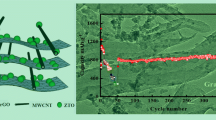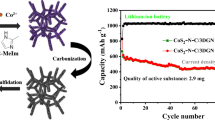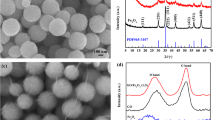Abstract
Titanium dioxide (TiO2)-based materials have been well studied because of the high safety and excellent cycling performance when employed as anode materials for lithium ion batteries (LIBs), whereas, the relatively low theoretical capacity (only 335 mAh g−1) and serious kinetic problems such as poor electrical conductivity (~ 10−13S cm−1) and low lithium diffusion coefficient (~ 10−9 to 10−13 cm2 s−1) hinder the development of the TiO2-based anode materials. To overcome these drawbacks, we present a facile strategy to synthesize N/S dual-doping carbon framework anchored with TiO2 nanoparticles (NSC@TiO2) as LIBs anode. Typically, TiO2 nanoparticles are anchored into the porous graphene-based sheets with N, S dual doping feature, which is produced by carbonization and KOH activation process. The as-obtained NSC@TiO2 electrode exhibits a high specific capacity of 250 mAh g−1 with a coulombic efficiency of 99% after 500 cycles at 200 mA g−1 and excellent rate performance, indicating its promising as anode material for LIBs.





Similar content being viewed by others
References
Aricò AS, Bruce P, Scrosati B, Tarascon JM, Van SW (2005) Nanostructured materials for advanced energy conversion and storage devices. Nat Mater 4(5):366–377
Armand M, Tarascon JM (2008) Building better batteries. Nature 451(7179):652–657
Beaulieu LY, Larcher D, Dunlap RA, Dahn JR (2000) Reaction of li with grain-boundary atoms in nanostructured compounds. J Electrochem Soc 147(9):3206
Belharouak I, Sun YK, Lu W, Amine K (2007) On the safety of the li4ti5o12∕limn2o4 lithium-ion battery system. J Electrochem Soc 154(12):A1083–A1087
Chen Z, Belharouak I, Sun YK, Amine K (2013) Titanium-based anode materials for safe lithium-ion batteries. Adv Funct Mater 23(8):959–969
Chu S, Zhong Y, Cai R, Zhang Z, Wei S, Shao Z (2016) Mesoporous and nanostructured TiO2 layer with ultra-high loading on nitrogen-doped carbon foams as flexible and free standing electrodes for lithium-ion batteries. Small 12(48):6724–6734
Dong Y, Pang H, Yang HB, Guo C, Shao J, Chi Y, Li CM, Yu T (2013) Carbon-based dots co-doped with nitrogen and sulfur for high quantum yield and excitation-independent emission. Angew Chem 125(30):7954–7958
Hummers WS Jr, Offeman RE (1958) Preparation of graphitic oxide. J Am Chem Soc 80(6):1339
Jannik J, Maier J (2004) Nanocrystallinity effects in lithium battery materials. Aspects of nano-ionics. Part 4. Cheminform 35(4):5215–5220
Jung HG, Jang MW, Hassoun J, Sun YK, Scrosati B (2011) A high-rate long-life li4ti5o12/li[ni0.45co0.1mn1.45]o4 lithium-ion battery. Nat Commun 2(7):516
Kamata M, Fujine S, Yoneda K, Kanda K, Esaka T (1999) Diffusion coefficient measurement of lithium ion in sintered li1.33ti1.67o4 by means of neutron radiography. Solid State Ionics 123(1):165
Larcher D, Tarascon JM (2015) Towards greener and more sustainable batteries for electrical energy storage. Nat Chem 7(1):19–29
Liang J, Jiao Y, Jaroniec M, Qiao SZ (2012) Sulfur and nitrogen dual-doped mesoporous graphene electrocatalyst for oxygen reduction with synergistically enhanced performance. Angew Chem Int Ed Engl 51(46):11496
Liu Z, Nie H, Yang Z, Zhang J, Jin Z, Lu Y, Xiao Z, Huang S (2013) Sulfur-nitrogen co-doped three-dimensional carbon foams with hierarchical pore structures as efficient metal-free electrocatalysts for oxygen reduction reactions. Nanoscale 5(8):3283–3288
Ma X, Ning G, Sun Y, Pu Y, Gao J (2014) High capacity li storage in sulfur and nitrogen dual-doped graphene networks. Carbon 79(6):310–320
Mi JEC, Nam KM, Lee Y, Song K, Park JT, Kang YM (2011) Phosphidation of li ti o nanoparticles and their electrochemical and biocompatible superiority for lithium rechargeable batteries. Chem Commun 47(41):11474–11476
Qiu B, Xing M, Zhang J (2014) Mesoporous tio2 nanocrystals grown in situ on graphene aerogels for high photocatalysis and lithium-ion batteries. J Am Chem Soc 136(16):5852–5855
Ren H, Yu R, Wang J, Jin Q, Yang M, Mao D, Kisailus D, Zhao H, Wang D (2014) Multishelled tio2 hollow microspheres as anodes with superior reversible capacity for lithium ion batteries. Nano Lett 14(11):6679–6684
Shen L, Yuan C, Luo H, Zhang X, Chen L, Li H (2011) Novel template-free solvothermal synthesis of mesoporous li4ti5o12-c microspheres for high power lithium ion batteries. J Mater Chem 21(38):14414–14416
Tarascon JM, Armand M (2001) Issues and challenges facing rechargeable lithium batteries. Nature 414:359–367
Wagemaker M, van Eck ERH, Kentgens APM, Mulder FM (2009) Li-ion diffusion in the equilibrium nanomorphology of spinel Li4+xTi5O12. J Phys Chem B 113:224–230
Wang Z, Lou XW (2012) Tio(2) nanocages: fast synthesis, interior functionalization and improved lithium storage properties. Adv Mater 24(30):4124–4129
Wang X, Sun G, Routh P, Kim DH, Huang W, Chen P (2014a) Heteroatom-doped graphene materials: syntheses, properties and applications. Chem Soc Rev 43(20):7067–7098
Wang X, Weng Q, Liu X, Wang X, Tang DM, Tian W, Zhang C, Yi W, Liu D, Bando Y, Golberg D (2014b) Atomistic origins of high rate capability and capacity of n-doped graphene for lithium storage. Nano Lett 14(3):1164–1171
Wang H, Ma C, Yang X, Han T, Tao Z, Song Y, Liu Z, Guo Q, Liu L (2015a) Fabrication of boron-doped carbon fibers by the decomposition of b 4 c and its excellent rate performance as an anode material for lithium-ion batteries. Solid State Sci 41:36–42
Wang C, Wu L, Wang H, Zuo W, Li Y, Liu J (2015b) Fabrication and shell optimization of synergistic tio2-moo3 core–shell nanowire array anode for high energy and power density lithium-ion batteries. Adv Funct Mater 25(23):3524–3533
Wu L, Yang J, Zhou X, Tang J, Ren Y, Yang N (2016) Enhanced electrochemical performance of heterogeneous si/mosi2 anodes prepared by a magnesiothermic reduction. ACS Appl Mater Interfaces 8(26):16862
Xing LB, Hou SF, Zhang JL, Zhou J, Li Z, Si W, Zhuo S (2015) A facile preparation of three dimensional n, s co-doped graphene hydrogels with thiocarbohydrazide for electrode materials in supercapacitor. Mater Lett 147:97–100
Yang J, Xi L, Tang J, Chen F, Wu L, Zhou X (2016) There-dimensional porous carbon network encapsulated sno 2, quantum dots as anode materials for high-rate lithium ion batteries. Electrochim Acta 217:274–282
Yu Z, Song J, Gordin ML, Yi R, Tang D, Wang D (2015) Phosphorus‐graphene nanosheet hybrids as lithium‐ion anode with exceptional high‐temperature cycling stability. Adv Sci 2(1–2). https://doi.org/10.1002/advs.201400020
Yun YS, Le VD, Kim H, Chang SJ, Baek SJ, Park S et al (2014) Effects of sulfur doping on graphene-based nanosheets for use as anode materials in lithium-ion batteries. J Power Sources 262(4):79–85
Zhao L, Hu YS, Li H, Wang Z, Chen L (2011) Porous li4 ti5 o12 coated with n-doped carbon from ionic liquids for li-ion batteries. Adv Mater 23(11):1385–1388
Zhou G, Paek E, Hwang GS, Manthiram A (2015) Long-life li/polysulphide batteries with high sulphur loading enabled by lightweight three-dimensional nitrogen/sulphur-codoped graphene sponge. Nat Commun 6:7760
Zhou X, Xi L, Chen F, Bai T, Wang B, Yang J (2016) In situ growth of sno 2, nanoparticles in heteroatoms doped cross-linked carbon frameworks for lithium ion batteries anodes. Electrochim Acta 213:633–640
Zhuang GL, Bai J, Tao X, Luo JM, Wang X, Gao Y, Zhong X, Li XN, Wang JG (2015) Synergistic effect of s,n-co-doped mesoporous carbon materials with high performance for oxygen-reduction reaction and li-ion batteries. J Mater Chem A 3(40):20244–20253
Funding
This study was funded by the National Nature Science Foundation of China (Grant no. 51204209).
Author information
Authors and Affiliations
Corresponding author
Ethics declarations
Conflict of interest
The authors declare that they have no conflict of interest.
Rights and permissions
About this article
Cite this article
Long, B., Chen, S., Wang, B. et al. A facile synthesis of heteroatom-doped carbon framework anchored with TiO2 nanoparticles for high performance lithium ion battery anodes. J Nanopart Res 20, 164 (2018). https://doi.org/10.1007/s11051-018-4263-x
Received:
Accepted:
Published:
DOI: https://doi.org/10.1007/s11051-018-4263-x




